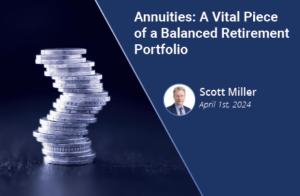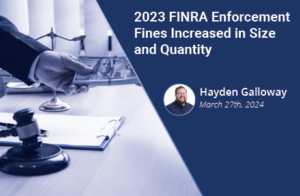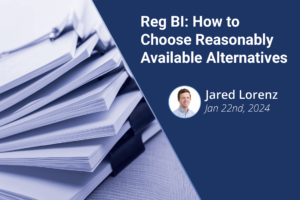January 22nd, 2024 | Jay McCready, Business Development, CapitalROCK
Do you feel like the Financial Industry’s regulatory environment is increasingly changing? It certainly feels like it. Especially, when considering legislation involving suitability, consumer protection, and best interest compliance within the last few years. With so many rules to comply with like: NY Regulation 187, the NAIC Model Regulation, Regulation Best Interest (Reg BI), and PTE 2020-02, a lot of firms are leveraging technology to stay on top of it. When considering the different tools available on the market today, one would likely come across RightBRIDGE and ask themselves, “How does RightBRIDGE tackle the changing best interest regulation?”. Well, I believe that can be illustrated through some seemingly unconnected topics. Let’s explore how elementary school math, social media, and best interest regulation relate and have a common thread.
Elementary Math: Show Your Work
I think for many of us that probably the first time we were required to show our work was likely back in elementary school. Elementary school math to be more specific. For me that would’ve been in the 80’s. The Dukes of Hazzard and the A-Team were some popular shows on TV. Atari was all the rage, with Nintendo’s new system not far behind. Those were great, but we lived out in the country, and I still loved to play outside. But like everyone else at that age, my time was not my own until I got my homework done. We likely all had those detested assignments that followed you home, that you would have to toil over and bring in to be checked out the next day. I remember sitting there in my room with my math book, and my math assignment that I dutifully transported home in my Trapper Keeper. Remember those? A page of problems, staring at me, forming rows like soldiers in rank standing between me and what I’d rather be doing. Essentially in my mind waging war on my freedom. I’d hem and haw about how unfair it was that I needed to do this math homework, but eventually, I would finally get to it. My mind focused singularly on getting the problems done. Once I got started, I’d realize that it’s not too bad. I would just rush along to get an answer plug it in, move to the next one, plug it in, and so on; until I fought my way to the bottom of the page and sweet freedom. However, you know how that played out. The next day at school, working my way through the day’s activities, we would come to math class, where I needed to produce my homework. I turned in my work, only to be called out by the teacher. She had an issue with the fact that I did not show my work. “Oh, what tediousness!”, I would think or something similar at a second-grade level. Why in the world did I need to show my work? But now looking back, of course, my indignation wasn’t appropriate. It was a product of the shortsightedness of youth. What was the teacher trying to accomplish? She was trying to teach me math, sure, but she also wanted to teach me the process of doing math. Getting the answers was not the only thing she was trying to impart to me as a teacher. She wanted to be certain that I understood how to arrive at the answers because she knew that the problems were going to get more complicated and more difficult. She wanted to make certain that I had a proper understanding of the procedure, and I knew how to implement the process to arrive at the answer. Having policies and procedures in place and being able to understand and implement them is important.
Pics or it Didn’t Happen
I’m sure you’ve all heard the popular phrase: “Pics or it didn’t happen.”, floating around on social media sites. A would-be challenge to those that post unbelievable or doubtful things without full photographic evidence. It’s often a funny call out, but really with everyone having phones in their pockets these days, in a way, it’s not a completely unreasonable request for proof. I feel like there has definitely been a drop in the number of outlandish fishing stories since smartphones have permeated society. And you know, it seems like we now naturally gravitate to providing proof of things without even thinking about it anymore. I was thinking about Thanksgiving a couple years ago. My fiancé and I determined early on that we would split up the holidays. We would go visit her family on either Thanksgiving or Christmas and then be with my family for the other. We alternate year after year. You see, she is from Western Pennsylvania and we both live down here in Virginia where my family resides, so it made sense to kind of split up time with our families. That way we weren’t running around instead of spending quality time with everyone every holiday. I’m sure a lot of folks have similar arrangements. Anyway, a couple years ago we were visiting her family for Thanksgiving. Typically, when we are with her family, she takes charge of the menu and its preparation. Sometimes for fun she likes to change things up, and on this occasion, she decided to roast a turducken in lieu of a traditional turkey. Now a turducken, for those that might not know, is a very unique Cajun creation, where they have taken a turkey, a duck, and a chicken; and have stuffed each bird of the smaller size into the next larger. Think of it as almost like poultry meets Russian dolls. While we were prepping it, we decided to send some pictures to some friends while wishing them a happy Thanksgiving. We shared pictures of it both before, and after it was roasted. We didn’t have to do that. It wasn’t like our friends were going to call us liars. It wasn’t like we would have fibbed about something odd like that, right? It was the natural progression of things to tell them about it and provide photos of it so that they could see it for themselves and what it entailed. Especially if they weren’t familiar with what a turducken was. These days it’s become very natural to share information and with the help of that computer in our pocket do so with a multitude of supportive media. The correspondence that we had with our friends was more meaningful, because we not only shared commentary with them. We also added to what was provided by giving them a visual understanding. In doing that, our narrative was more complete.
Best Interest Regulation in recent years.
How do the previous anecdotes parallel with best interest regulation in the financial services industry? Well, let’s look at some of the different regulations that affect financial professionals today.
I came to work at CapitalROCK at the very end of 2019. A lot of legislative events were taking place at that time. Just in the year prior the New York Department of Financial Services had put together a best interest rule that was later called New York’s Regulation 187. It defined the best interest standard when selling annuity and life insurance products in the State of New York. It became effective August 1st, 2019, for annuities and February 1st, 2020, for life insurance. Later in a guidance note on February 12, 2020, the Department provided clarification to the question posed:
Question: Generally, how will the Department approach its review of a transaction for compliance with the best interest standard in section 224.4(b)?
Answer: The Department views the best interest standard more as a process than a singular outcome so the Department expects to focus on the producer’s process and analysis from the initial gathering of suitability information and initial consideration of the products available for sale by the producer to the subset of those products that would be suitable for the particular consumer and finally the recommendation to the consumer from among the suitable products. A producer should expect the Department to request information/documentation about the steps taken and analysis performed during that process.
Citation: 11 NYCRR 224.0, 224.4(b), 224.5(b),
At about the same time in 2020, the National Association of Insurance Commissioners (NAIC) wanted to have a best interest standard upheld at the State level in lieu of the DOL proposed regulation that was vacated in 2018. The NAIC model is for annuity sales. At present, 41 States have adopted regulations based on the NAIC’s model regulation. The NAIC also conducted a series of FAQ’s. Here is an excerpt that speaks to the four obligations of the producer or insurer:
Question: What is the best interest standard of conduct and how would a producer or insurer satisfy it?
Answer: To satisfy the best interest obligation, a producer or an insurer must satisfy four obligations: 1) care; 2) disclosure; 3) conflict of interest; and 4) documentation.
To satisfy the four obligations, when making a recommendation, producers must:
• Know the consumer’s financial situation, insurance needs and financial objectives;
• Understand the available recommendation options;
• Have a reasonable basis to believe the recommended option effectively addresses the consumer’s financial situation, insurance needs and financial objectives;
• Communicate the basis of the recommendation to the consumer;
• Disclose their role in the transaction, their compensation, and any material conflicts of interest; and
• Document, in writing, any recommendation and the justification for such recommendation.
Final FAQ July 2021.pdf (naic.org)
In a tandem series of events to the State level initiatives previously mentioned, the Securities Exchange Commission had approved their Regulation Best Interest (Reg BI) in June of 2019. And it ultimately came into effect a year later in June of 2020. This was the best interest standard for broker-dealers when they make a securities transaction or a securities investment strategy recommendation. The SEC Reg BI also focuses on four obligations. Those being: Disclosure, Care, Conflict of Interest, and Compliance obligations. There have been many staff bulletins released in relation to these obligations. They have typically been addressed to both broker-dealers as well as investment advisors. Although investment advisors fall under the separate Investment Advisers Act of 1940 or the “fiduciary standard”, they are both drawn from the same principles. In these bulletins, especially the one delving into the Care Obligation, it was highlighted that Reasonably Available Alternatives should be considered based on a client’s specific needs. And in its posed questions delt with the need for documentation by answering in this way:
Question: Should firms document the evaluation of reasonably available alternatives?
Answer: Although there is no requirement of such documentation, in the staff’s view, it may be difficult for a firm to demonstrate compliance with its obligations to retail investors, or periodically assess the adequacy and effectiveness of its written policies and procedures, without documenting the basis for certain recommendations.[60] This could include documentation of the consideration of reasonably available alternatives.[61] The staff believes documentation demonstrating that the financial professional considered reasonably available alternatives can be particularly important where a recommendation may seem inconsistent with a retail investor’s investment objectives on its face and/or poses conflicts of interest for the firm or the financial professional.[62]
Lastly, by 2015, the Department of Labor indicated that it was going to update the rules and requirements for financial professionals highlighting that they needed to put the best interest of their clients above their own. This was the first iteration of the DOL‘s fiduciary suitability rule. We’ve seen them return to this several times. The rule was originally scheduled to be phased in during 2017 to 2018, but in 2018, the US Fifth Circuit Court of Appeals vacated the rule. As we know, the situation is fluid, because they’ve returned to it a few times since then, in fact we are currently awaiting the finalization of the latest iteration, the Retirement Security Rule. The previous big push by the DOL was the Prohibited Transaction Exemption, also known as PTE2020-02, that was announced December 18th, 2020, and went into effect February 16th, 2021. In April 2021 the Department released an FAQ page to help with the rule. A question that was posed that I will highlight from those FAQ’s was:
Question: What is required to comply with PTE 2020-02?
Answer: PTE 2020-02 conditions prohibited transaction relief on financial institutions (SEC- and state-registered investment advisers, broker-dealers, banks, and insurance companies) and their investment professionals (employees, agents, and representatives) providing advice in accordance with the Impartial Conduct Standards. Financial institutions must also acknowledge in writing their and their investment professionals’ fiduciary status under Title I of ERISA and the Internal Revenue Code, as applicable, when providing investment advice to the retirement investor, and they must describe in writing the services to be provided and the financial institutions’ and investment professionals’ material conflicts of interest. Financial institutions must document the reasons that a rollover recommendation is in the best interest of the retirement investor and provide that documentation to the retirement investor. Financial institutions must adopt policies and procedures prudently designed to ensure compliance with the Impartial Conduct Standards and that mitigate conflicts of interest, and must conduct an annual retrospective review of compliance.
As can be seen, a common thread develops amongst these various regulations that have come up in the last few years. That is that firms need to implement policies and procedures that help their financial professionals show both a duty of care while avoiding conflict of interest and showing compliance with said processes. And that the financial professional, whether they be insurance producers, broker- dealers, or registered investment advisors, need to show that their firms have policies and procedures in place and that they have followed them. In other words, show your work, and pics or it didn’t happen. Show us that you have a process in place and that you follow the process and that you have documented consideration of reasonable alternatives related to the aspects of the client’s needs and the features of the product.
So, how does RightBRIDGE tackle best interest regulation? It does so by providing: firms a structure in which they can overlay their policies and procedures, financial professionals a way to show their adherence to the firm’s process, and collectively, providing both firms and their financial professionals a way in which to show that they have done so. At the crux of this is the platform’s trademark feature ReasonText™. ReasonText™ is an automated note taking feature that is configured with a firm’s compliance rules in mind. The beauty of it is that it is generated contemporaneously as a producer works through the client questionnaire and documents the clients’ preferences, and needs. ReasonText™ is then automatically paired with reasonably available alternatives and built into a report for documentation. Remember me complaining about the drudgery of showing my work when I was doing that arithmetic in elementary school? Well, what if I had just needed to do the mental work, and there was a system drawing out the moves that I was making mentally and putting them on paper. Remember how I was reflecting on how it seems that we just automatically take pictures of things we want to share with our family and friends. A report that is automatically generated is much the same. Painlessly crafted all while the financial professional is collecting the data that they would have to collect anyway. To conclude, the obligation for firms and financial professionals to document their processes is only going to become more crucial. RightBRIDGE helps to alleviate the pain by providing more capacity through systemization and nearly immediate documentation.
The material contained in this communication is informational and general in nature. The material contained in this communication should not be relied upon or used without consulting appropriate legal or financial representatives to consider your specific circumstances. This communication was published on the date specified and may not include any changes in the topics, laws, rules, or regulations covered.






